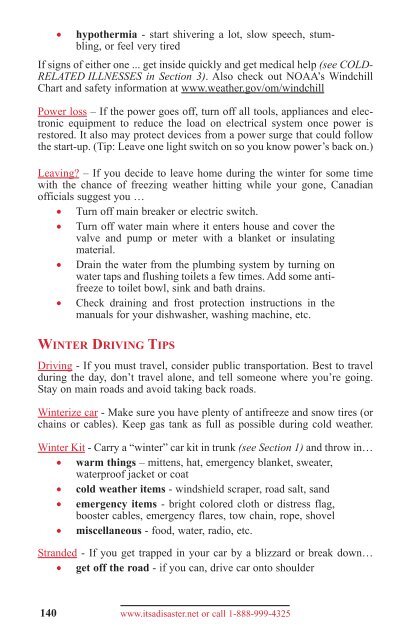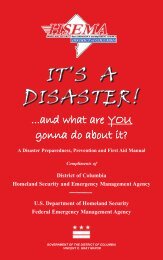disaster 5th 1108_5th ed 2011 - Homeland Security and Emergency ...
disaster 5th 1108_5th ed 2011 - Homeland Security and Emergency ...
disaster 5th 1108_5th ed 2011 - Homeland Security and Emergency ...
You also want an ePaper? Increase the reach of your titles
YUMPU automatically turns print PDFs into web optimized ePapers that Google loves.
• hypothermia - start shivering a lot, slow speech, stumbling,<br />
or feel very tir<strong>ed</strong><br />
If signs of either one ... get inside quickly <strong>and</strong> get m<strong>ed</strong>ical help (see COLD-<br />
RELATED ILLNESSES in Section 3). Also check out NOAA’s Windchill<br />
Chart <strong>and</strong> safety information at www.weather.gov/om/windchill<br />
Power loss – If the power goes off, turn off all tools, appliances <strong>and</strong> electronic<br />
equipment to r<strong>ed</strong>uce the load on electrical system once power is<br />
restor<strong>ed</strong>. It also may protect devices from a power surge that could follow<br />
the start-up. (Tip: Leave one light switch on so you know power’s back on.)<br />
Leaving – If you decide to leave home during the winter for some time<br />
with the chance of freezing weather hitting while your gone, Canadian<br />
officials suggest you …<br />
• Turn off main breaker or electric switch.<br />
• Turn off water main where it enters house <strong>and</strong> cover the<br />
valve <strong>and</strong> pump or meter with a blanket or insulating<br />
material.<br />
• Drain the water from the plumbing system by turning on<br />
water taps <strong>and</strong> flushing toilets a few times. Add some antifreeze<br />
to toilet bowl, sink <strong>and</strong> bath drains.<br />
• Check draining <strong>and</strong> frost protection instructions in the<br />
manuals for your dishwasher, washing machine, etc.<br />
WINTER DRIVING TIPS<br />
Driving - If you must travel, consider public transportation. Best to travel<br />
during the day, don’t travel alone, <strong>and</strong> tell someone where you’re going.<br />
Stay on main roads <strong>and</strong> avoid taking back roads.<br />
Winterize car - Make sure you have plenty of antifreeze <strong>and</strong> snow tires (or<br />
chains or cables). Keep gas tank as full as possible during cold weather.<br />
Winter Kit - Carry a “winter” car kit in trunk (see Section 1) <strong>and</strong> throw in…<br />
• warm things – mittens, hat, emergency blanket, sweater,<br />
waterproof jacket or coat<br />
• cold weather items - windshield scraper, road salt, s<strong>and</strong><br />
• emergency items - bright color<strong>ed</strong> cloth or distress flag,<br />
booster cables, emergency flares, tow chain, rope, shovel<br />
• miscellaneous - food, water, radio, etc.<br />
Str<strong>and</strong><strong>ed</strong> - If you get trapp<strong>ed</strong> in your car by a blizzard or break down…<br />
• get off the road - if you can, drive car onto shoulder<br />
140 www.itsa<strong>disaster</strong>.net or call 1-888-999-4325





